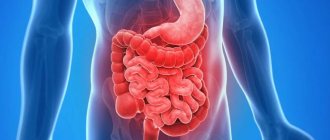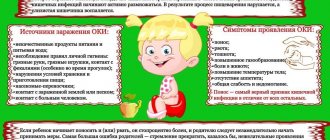A child has a stomach ache: what to do?
If a child has a stomach ache, you need to determine the degree of pain, its nature and location.
You can’t give painkillers right away, as this will interfere with understanding the causes of the pain. If the abdominal pain is sharp, incessant, accompanied by fever, diarrhea, vomiting, and other alarming symptoms, call an ambulance. There are many reasons why a child has a stomach ache. The most harmless of them is indigestion or overeating.
Causes of abdominal pain in a child
What to do if your child has a stomach ache? First of all, you need to understand the cause of the pain. The stomach may hurt after eating if the child ate heavily and then acted out. Pain can be triggered by severe physical activity. Painful sensations in the abdominal area can be symptoms of physiological problems or appear as a result of infectious diseases.
Common causes of abdominal pain in children:
- Bloating, constipation. It happens in children aged one year and older. If a child has not gone to the toilet for a long time for various reasons (often psychological - stress, overwork), this can cause abdominal pain.
- Abdominal muscle strain. It happens after heavy physical exertion (carrying weights, trying to move heavy objects) or after a complicated cold, when severe vomiting and coughing provoke abdominal cramps.
- Colic. This problem plagues many babies under one year old. With colic, the baby cries and draws in his legs. With colic there is no fever. What to give a child for abdominal pain in this case: dill or anise tea, Plantex (after consulting a pediatrician). You can apply a warm diaper to the tummy, carry the baby vertically in your arms, or roll the tummy on a large inflatable Pilates ball.
- Intestinal obstruction. The disease occurs in one-year-old children. Symptoms: blood in the stool, nausea, vomiting. If you suspect an obstruction, you need to call an ambulance and go to the hospital. The problem cannot always be solved with medication; sometimes it is necessary to operate.
- Flatulence is an accumulation of gases in the body. After eating with flatulence, the child may burp, causing frequent belching. The child sleeps poorly, is capricious, and does not want to eat. With such symptoms you need to see a doctor; self-medication is dangerous, because flatulence is often a harbinger of more serious diseases.
- Intolerance to certain foods. By the age of four, children may develop a food allergy, a clear rejection by the body of certain foods. Such products can cause abdominal cramps, turning into colic, bloating, diarrhea, and nausea. Carbonated drinks and foods containing lactose and gluten top the list of foods intolerant to children. Listen to your child and don't force him to eat foods he doesn't like. In order not to be tormented by the question of why a child often has a stomach ache, be attentive to the child’s diet. Even if you are confident in the benefits of prepared foods, this does not mean that they will be useful for your baby.
- Worms cause mild but constant pain in the abdomen. Associated symptoms are headaches, flatulence, itching of the anus.
- Inflammation in the testicular area. Acute pain in the scrotum area spreads to the lower abdomen. It happens due to a bruise or as a result of a hernia. You should consult a doctor immediately.
- Gastroenteritis is inflammation of the mucous membrane of the stomach and small intestine. Triggered by bacteria and viruses. Symptoms of gastroenteritis: diarrhea, nausea, fever, vomiting.
- Pyelonephritis. The disease appears in girls and is manifested by acute and cutting pain in the lumbar region, side, and lower abdomen. Leads to fever, increased sweating, severe weakness and headache. The doctor must prescribe the correct treatment. Sometimes surgery is required.
- Jaundice. A dangerous and contagious liver disease. External symptoms: yellowing of the eyes, dark urine and a strong odor. If the disease occurs, urgent hospitalization is required.
- Appendicitis is inflammation of the appendix. Dull, aching, cramping pain in the lower abdomen. Not necessarily in the classic location of the appendix (on the right side); in children, painful sensations can be localized in different ways. Additional symptoms: sudden increase in temperature, refusal to eat, nausea, vomiting. Urgent hospitalization is required.
There are situations in which it is unacceptable to expect that “it will go away on its own.”
In what cases do you urgently call an ambulance?
You definitely need to examine the child, listen carefully to his complaints, remember how he felt the day before, and try to figure out what could have caused the pain. Symptoms for which you need to call an ambulance:
- the child was very weak and lost consciousness;
- there was an injury, after which abdominal pain began;
- the pain started at night, the child is unable to go to the toilet;
- heat;
- the child refuses food and water;
- diarrhea, vomiting, nausea;
- pain is felt in the navel area;
- unbearable pain;
- skin rashes;
- the child is small, under five years old, the pain leads to whims and tears, lasts more than two hours.
If the pain does not go away for a long time, or the temperature is high, call a doctor. In this case, it is better to be safe than to start the disease.
What can you do before the ambulance arrives?
What to do when a child has a stomach ache and the ambulance doctors have not arrived yet:
- There is no need to give any medications, this may blur the picture.
- You can’t eat, you can’t drink drinks that cause gas (soda, juices, milk), it’s best to drink a lot of clean water.
- The child has a stomach ache, what can be given at a high temperature: any antipyretic that he tolerates well. It is necessary to monitor changes in temperature so that it does not increase sharply to low-grade fever.
- Do not heat the sore spot, this will worsen the condition and may provoke an inflammatory process.
Functional abdominal pain
In addition to dangerous diseases, a child may have functional pain. Painful sensations in the abdominal area appear in children aged 7 to 15 years. They are usually associated with stress and overwork. This is how the body signals in an accessible form that it is difficult for it to cope with stress. If a student often takes time off from classes because his stomach hurts, he may be mistaken for a malingerer. But it is not always the case. At this age, the stomach may often hurt for the following reasons:
- physical and psychological stress at school;
- with psychological difficulties of the transition period, when emotional problems affect the child’s health;
- the body grows and develops rapidly, not all organs have time to work harmoniously, food digestion may be impaired;
- nervous disorders lead to constipation or, conversely, diarrhea;
- in girls, during the period of preparation of the body for the first menstruation, abdominal pain may be frequent.
If your child has functional pain and not a serious illness, there is no need to brush it off and expect the problem to go away with age. We need to help the child overcome the pain syndrome.
What to give to a child when the stomach hurts with functional pain:
- you can drink herbal soothing and fortified teas;
- support the child morally, praise, help, let him understand that home is his fortress;
- in the fall and summer (for schoolchildren it is especially important during the difficult third quarter and after it) give the child multivitamin preparations;
- give your child a weekend, don’t overload him with studies and responsibilities, let him often feel lightness and not the burden of non-childish problems on his shoulders;
- how to treat when a child has a stomach ache (functional pain): if it is severe, give Paracetamol or Ibuprofen;
- It is advisable to record somewhere, write down when the pain appears, what you can associate it with, how you cope with it, what medications you use.
A child has a stomach ache, what to give for indigestion?
If the problem is the body’s rejection of a specific product or combination of products, you need to:
Possible causes of abdominal pain at night in children under one year of age
In every family, a situation arises when a child begins to complain of abdominal pain. This certainly worries parents, but they do not always give due importance to their child’s complaints. Moreover, home treatment begins with the help of various drugs.
Experts warn that pain may signal a serious illness that requires medical attention.
Therefore, it is not recommended to give an infant antispasmodics without a doctor’s prescription, since their effect can hide the overall picture and complicate the identification of the causes of the disease.
Abdominal pain in a child may indicate a hidden disease
Why does my child have a stomach ache at night?
The causes of nighttime sickness in children can be very different. In infants under one year old, finding out what hurts and how it hurts can be difficult, because they cannot talk about the discomfort. However, by external signs, the mother can determine that the child is not all right.
Often night pain is accompanied by loud crying, the baby may writhe and press his legs to his stomach. Parents do not always understand how to react to such actions and what to do. And evening time is not conducive to much thought.
Therefore, there is only one way out - to take the baby in your arms, cover it warmly, and lull it to sleep. For some time, maternal warmth and gentle movements calm the baby.
When the sensations return, malaise appears again, since in fact the cause of crying is pain.
For your information! Pediatricians explain to parents that pain can be caused by diseases and pathological conditions, for example, overeating, colic, constipation, allergic reactions, intestinal infections, food poisoning, appendicitis.
Common reasons:
- Pediatricians cite infectious diseases caused by rotavirus as a common reason why a child has a stomach ache at night. During the day, the temperature may remain normal, but by night it rises, resulting in body aches and abdominal discomfort;
- A significant factor in the malaise is considered to be the transfer of infants to a mixed diet. When new products are introduced into the diet, in addition to breast milk and infant formula, the functioning of the gastrointestinal tract is often disrupted in infants. They lack digestive enzymes to digest new food. This usually leads to stomach cramps and constipation, causing abdominal pain. They intensify during night sleep, the child cries, twists his legs, presses them to his stomach;
- In some cases, abdominal pain does not have a clearly defined physiological cause. The reasons for their appearance include emotional stress associated with an unfavorable psychological climate at home, for example, family quarrels.
Important! In all cases, if a child suffers from recurrent abdominal pain that is not related to an “acute abdomen,” a routine examination by a pediatrician is required to make a diagnosis and prescribe the correct treatment.
Differences in pain syndrome according to its origin
Why does a child under one year old have a stomach ache with ARVI?
Experts say that to find out the cause of the malaise, it is useful to record all the factors preceding it: the time of onset, stool characteristics, the presence of vomiting, fever, and the baby’s complaints, if possible. This will help the pediatrician find the origin of the pain syndrome. For example, with gastroenteritis, a child begins to vomit even before the abdominal pain, and with appendicitis, pain occurs before vomiting.
Parents will help the doctor recognize the causes of abdominal pain if they document the preceding factors
Important! Recording such symptoms will help the doctor decide what kind of help to provide to the baby: surgical or therapeutic. This will save time and avoid serious complications.
Experts remind parents of situations that should alert parents:
- A typical picture often occurs with ARVI, when first there are signs of a cold, then against its background the child has a stomach ache at night. The condition is called “acute pain”; if it is present, you need to pay attention to the nasopharynx and measure your body temperature. If the disease progresses, the child feels sick and has loose stools;
- A sharp cramping or aching pain in a baby makes one assume that appendicitis is beginning. The child complains of the following symptom: abdominal pain in the navel area. Sometimes the pain spreads to the entire abdomen, gradually moving to its lower right side;
- Paroxysmal pain in the solar plexus area, accompanied by frequent urge to defecate, characterizes injury (impact, fall from a height). Often the child takes a forced position: he lies on his right side, pressing his legs to his stomach, and does not allow him to touch his tummy.
The nature of abdominal pain in a child
The child has a fever and a stomach ache
Explaining the syndrome of abdominal pain in a child, experts emphasize: its character can tell parents what is happening with the baby. There are three characteristics of pain:
- Visceral pain occurs when irritants affect an internal organ, such as the stomach or intestines. Discomfort is in the upper abdomen if the pathological process occurs in the lower esophagus or stomach. Pain around the navel is felt due to irritation of the small intestine. Malaise in the lower abdomen is felt with problems in the colon;
- Pain due to irritation of the peritoneum occurs during inflammation, is acute, severe and limited in location; coughing and movement can intensify it. Such ailment occurs in cases where inflammation has spread beyond the organ, for example, with appendicitis, peritonitis, perforation of a stomach or intestinal ulcer;
- Referred pain, although having similar characteristics, can be caused by a lesion outside the abdominal cavity. This occurs due to the fact that several organs may have common nerve fibers; when a pain impulse reaches the brain, its perception is disrupted. A classic example is the pain experienced by a child with pneumonia localized in the lower lobes of the lungs. At the same time, the illness is felt as if the stomach hurts.
Referred abdominal pain in a child may be caused by pneumonia
First aid before the doctor arrives
A child has a stomach ache and diarrhea - what to do with a baby
Treatment for abdominal pain depends on the cause of its occurrence, the condition of the child, and the doctor’s diagnosis. If the disease does not pose a threat to the baby’s life, you can be treated at home:
- If your child has a stomach ache during the day, you need to put him down for at least 15 minutes. After a short rest, the unpleasant sensations may disappear for a while, the baby will feel better and will be able to hold out until the doctor arrives;
- Be sure to give your baby plenty of fluids, laxatives or enemas only as prescribed by the attending physician;
- If a child is unwell, it is necessary to monitor his condition. If your stomach hurts for two hours or more, calling an ambulance is inevitable.
Important! It is not recommended to self-medicate, take painkillers or antibiotics without a doctor's recommendation. Using traditional medicine that has no evidence of effectiveness can only worsen the situation.
In more serious cases, no medications should be given, as they complicate the diagnosis; in case of appendicitis, acute pancreatitis, or intestinal obstruction, surgical intervention may be required.
Reasons why a child has a stomach ache at night
It is quite common that a child has a stomach ache at night. This is one of the most frequent and common complaints in children. Having heard such a statement from their baby, parents try to help him get rid of the unpleasant feeling. Usually, a variety of analgesics or antispasmodics are used, which are aimed at eliminating abdominal discomfort. But it very often happens that under the guise of simple pain, quite serious types of diseases are hidden, which without surgical intervention can lead to dire consequences.
Cases where you need to call an ambulance
If a child has a stomach ache in the evening or at night, the following symptoms are a reason to seek emergency medical help:
- The baby's age does not exceed three months, he began to feel sick and had diarrhea;
- The symptom of “acute abdomen” lasts more than 2 hours, the baby suffers from pain;
- Acute pain is localized in one part of the abdomen, for example, the right;
- The pain is spasmodic in nature and lasts more than 12 hours;
- The child began vomiting blood or bile and defecating with blood;
- Sharp abdominal pain, accompanied by fever, vomiting, diarrhea, the anterior abdominal wall is tense;
- A swollen or hard-feeling belly;
- Pain in the groin, tenderness and swelling of the testicle;
- Injuring a child in front of the parents.
In case of acute pain syndrome, it is necessary to call emergency assistance
The main thing to remember! If a child has a stomach ache at night, you should not self-medicate and delay calling a doctor, as the disease develops quickly. The longer the baby endures pain, the more difficult it is to make a diagnosis.
It is not the pain that is dangerous, but the complications of the disease that caused it. They are the ones who pose the greatest danger to the child. It is easier to make a diagnosis on time than to treat severe complications, such as peritonitis. Therefore, it is more important to call a doctor and make sure that everything is in order than to hope for self-healing, exposing the child to great risk.
Dangerous diseases and surgery
One of the most serious types of the disease is acute appendicitis (inflammation of the rectal appendix occurs). The appendix usually develops in children between the ages of 8 and 14 years. This type of illness can strike at any time, and you can get sick at any age. Unfortunately, it is often difficult to identify in children, since it tries to disguise itself as attacks of gastritis, an infection of the urinary system. It is possible that it will even be similar to ARVI or, oddly enough, pneumonia.
There are cases that after a child gets a sore throat, after 5-7 days he will begin to complain of constant pain in the navel area or below. You should not immediately regard this as a manifestation of appendicitis. A child’s body is designed in such a way that abdominal pain can occur for a variety of reasons. Here is the simplest example: a baby has loose stools that do not return to normal. There are no other serious signs indicating illness. They begin to treat the baby for a common intestinal infection, but he has a completely different illness.
Why does my stomach hurt?
Before trying to determine the cause of pain, it is necessary to find out how intense it is and where it is localized.
In case of severe pain, babies, as a rule, prefer to lie down, taking not very comfortable positions. They turn and stand up, while the children are very careful, slowly. The symptom can be sharp (dagger pain), dull aching or stabbing. To determine the cause of pain, it is important to track where its epicenter is located. So, the left side of the peritoneum may indicate intestinal obstruction/inflammation. In addition, the pancreas is located on the left, which can also cause unpleasant symptoms. If there is pain on the right, this may also indicate problems with the intestines, but if the symptom is localized in this area, in addition, pathologies of the liver and gallbladder or tract are possible (for example, dyskinesia, cholecystitis, etc.)
If a child has a fever and a stomach ache, then an intestinal infection or appendicitis is likely. In any case, if such signs occur, parents should immediately call a doctor who can determine the cause of the baby’s illness. If, in addition to the main symptoms, there is blood in the child’s stool or vomit, this is a good reason to urgently call an ambulance.
In the navel area
The main causes of pain in the navel area are overeating or incomplete/untimely bowel movements. Treatment in this case is simple: it is necessary to reduce the amount of food given to the child, eliminate snacks between main meals, and remove fatty foods from the diet. If after this the baby still has pain around the navel, give him an enema (even if he has bowel movements often) - this will help alleviate the patient's condition. An alternative option is to give your son or daughter mild laxatives.
Other diseases that are sometimes indicated by pain below the navel are:
- intestinal hernia (it is provoked by constipation, diarrhea, dysbacteriosis, disruptions of the digestive process);
- umbilical hernia (occurs in babies who often cry and thereby strain their tummy);
- intervertebral hernia (sometimes pinched nerves in the spine cause pain in the lower abdominal cavity);
- appendicitis (this is possible if the child complains that his lower abdomen hurts, which is accompanied by fever);
- gastroduodenitis (with prolonged pain below the navel, inflammation of the gastric mucosa can be assumed; the symptom often appears after eating).
Cramping pain
If, against the background of a normal state of health, a child experiences attacks of abdominal pain, this may indicate intussusception (invasion of one area of the intestine into another due to impaired peristalsis of the organ). Sometimes attacks are accompanied by vomiting and an increase in body temperature, while at the beginning of the disease the stool may not differ from normal. Acute cramping pain in the abdomen in children under 12 months is expressed by unreasonable crying/screaming, constant restlessness, poor sleep, and drawing the legs toward the chest.
With intussusception, the attacks subside as abruptly as they appeared: the children calm down, begin to eat and play normally again. The frequency of pain is the main symptom of this disease. As the pathology develops, attacks become more frequent, becoming longer and more pronounced. As a rule, the disease affects children 6-12 months old, caused by improper introduction of complementary foods containing fruit/vegetable components.
Vomiting and diarrhea in a child
If these symptoms are not accompanied by fever, then there can be a huge number of reasons that caused them. When a baby has a stomach ache and diarrhea, this does not necessarily indicate the presence of any pathology (only a doctor can make an accurate diagnosis). The most common cause of loose stools and nausea is E. coli, which more often manifests itself in the summer season. The reason for this is insufficient hand hygiene or eating dirty fruits.
In addition to diarrhea and vomiting, the child sometimes has a fever, dehydration begins, there is sometimes an admixture of blood or mucus in the stool, and the general condition will be lethargic. When infected with E. coli, each meal ends with a bowel movement. The cause of these symptoms may be poisoning from stale food, poisons or medications (antibiotics). In this case, symptoms appear within a couple of hours after toxins enter the body.
Sharp pain
As a rule, colic or pain in the stomach in children occurs due to intestinal obstruction. The first pathology most often occurs in children 6-12 months old and is accompanied by nausea/vomiting, the second, as a rule, is diagnosed in infants under one year old. If 2 hours after the onset of pain the child’s condition has not improved and the tummy continues to hurt, the baby should be taken to a doctor for examination.
In the morning
If a child complains of abdominal pain that occurs in the morning, there may be several reasons for this. The most common among them are:
- allergy;
- intestinal infection;
- upset stomach;
- appendicitis;
- helminthic infestation.
Sometimes children have stomach ache in the morning due to nervousness associated with their reluctance to attend kindergarten/school. The reasons for this are problems with teachers and peers, so parents should talk with the child and try to find out the causes, intensity, and location of pain. If it is very strong, and the baby takes unnatural positions lying down, slowly, carefully rises and turns over, you need to show him to the pediatrician. In some cases, these signs indicate appendicitis or peritonitis.
What symptoms require urgent help?
There is a great danger that the intestinal tissue will begin to die. Young children are exposed to this due to the fact that parents incorrectly introduce complementary vegetables or fruits into their daily diet. Boys are more susceptible to this disease than girls. This may also occur due to various tumors or pathologies that can impair mobility. This terrible disease appears suddenly:
- The baby cries a lot, is covered in sweat and often knocks his feet on the floor.
- After the first attack (on average it can last from 7 to 10 minutes), the child becomes very lethargic and signs of apathy appear. With each subsequent attack, the stomach will swell.
- Gag reflexes are possible, and the ejected mass contains mucus and blood.
- Often the temperature rises.
As soon as parents notice these symptoms, the baby should be hospitalized immediately. If less than 12 hours have passed since the first such “attack,” the damaged part of the intestine can be saved.
In order to confirm this diagnosis, an x-ray is usually taken, before which an enema with a certain solution is administered (standardly barium sulfate). This will make the damaged area easy to spot in the pictures. If you manage to react in a timely manner, surgical intervention will not be required. Air under pressure will be supplied through the rectum, and after a certain period of time it will become what it should be.
Otherwise, you cannot do without surgeons. They will manually correct the damaged area using laparoscopy. There are cases when the injured part (it was not possible to avoid tissue necrosis) the surgeon has to cut out and then stitch together the healthy parts of the intestine.
All of the above points should alert parents, indicating that the baby is sick, and this may not be simple pain at all.
How can parents recognize the cause of abdominal pain?
There are many reasons why children may have stomach pain.
- Banal overeating: Often pain occurs simply because children overeat. For example, on holidays or when visiting grandparents, children eat too much sweets. Gas formation when digesting carbohydrates or fiber or an increase in blood sugar levels can cause abdominal pain.
- Holiday drinks: drinking sodas and lemonades, which may not be compatible with other foods and often cause indigestion and distension of the intestinal walls. Spicy and fatty foods, such as chips, can cause stomach upset.
Often abdominal pain is caused by constipation. In this case, children complain of pain around the navel. If you ask them when the last time they went “big”, it turns out that it was a long time ago. Ask the child to go to the toilet, and find out if he succeeded, if the stomach continues to hurt if the child had stool. With a viral infection, abdominal pain lasts at least a day before the child experiences vomiting and diarrhea.
Critical situations when you can't wait any longer
If the pain does not subside within 2 hours, you need to call an ambulance and urgently take the baby to the nearest hospital. The younger the child, the much more difficult it is to determine the correct diagnosis for him, since he is not able to describe all the sensations inside.
When examining the baby, an experienced specialist will be able to see the difference in the subtle tone of the abdominal muscles. A complete blood count and ultrasound scan are usually done to confirm the diagnosis. There are extreme measures when the child needs to be left in the hospital so that his condition is closely monitored. But almost all parents strongly protest, because they don’t want to leave their child in the hospital.
There is no need to argue with surgeons; they know better. It may happen that in a few hours an urgent operation will be required. Therefore, the child must be under the supervision of doctors, otherwise it may not be possible to provide timely assistance.
In most cases, appendicitis is removed using the surgical method of laparoscopy. In this case, the doctor makes small punctures in the abdomen, inserts certain medical instruments into them and begins to carry out the removal operation itself. This method of removal poses the least threat; it has the lowest percentage of intestinal infections.
After the child is discharged, the doctor will give recommendations that should be strictly followed: what nutrition is needed, how long the diet will be, what physical activity is allowed, and so on. There are no general universal rules, since each organism is unique and inimitable in its own way.
What to do
How to behave when a child says that his stomach hurts?
- First of all, observe his condition. If there are no other symptoms - vomiting, dizziness, diarrhea, it may be enough for the child to simply go to the toilet or give him smecta.
- Take the temperature, ask in which area it hurts , find out how often this happens to him. Maybe the baby was patient before this and didn’t say that something was hurting him.
- After the baby has sucked the breast, hold it in a “column” until a belch appears , this means that excess air has come out of the newborn’s stomach.
- If the cause of abdominal pain is gases, then exercise for the baby will help relieve bloating. Press the legs against the tummy, stroke the newborn's belly clockwise, help the gases escape by inserting a special tube.
A child has a stomach ache: what to do?
If a child has a stomach ache, you need to determine the degree of pain, its nature and location. You can’t give painkillers right away, as this will interfere with understanding the causes of the pain. If the abdominal pain is sharp, incessant, accompanied by fever, diarrhea, vomiting, and other alarming symptoms, call an ambulance.
There are many reasons why a child has a stomach ache. The most harmless of them is indigestion or overeating.
Causes of abdominal pain in a child
What to do if your child has a stomach ache? First of all, you need to understand the cause of the pain. The stomach may hurt after eating if the child ate heavily and then acted out. Pain can be triggered by severe physical activity. Painful sensations in the abdominal area can be symptoms of physiological problems or appear as a result of infectious diseases.
Common causes of abdominal pain in children:
- Bloating, constipation. It happens in children aged one year and older. If a child has not gone to the toilet for a long time for various reasons (often psychological - stress, overwork), this can cause abdominal pain.
- Abdominal muscle strain. It happens after heavy physical exertion (carrying weights, trying to move heavy objects) or after a complicated cold, when severe vomiting and coughing provoke abdominal cramps.
- Colic. This problem plagues many babies under one year old. With colic, the baby cries and draws in his legs. With colic there is no fever. What to give a child for abdominal pain in this case: dill or anise tea, Plantex (after consulting a pediatrician). You can apply a warm diaper to the tummy, carry the baby vertically in your arms, or roll the tummy on a large inflatable Pilates ball.
- Intestinal obstruction. The disease occurs in one-year-old children. Symptoms: blood in the stool, nausea, vomiting. If you suspect an obstruction, you need to call an ambulance and go to the hospital. The problem cannot always be solved with medication; sometimes it is necessary to operate.
- Flatulence is an accumulation of gases in the body. After eating with flatulence, the child may burp, causing frequent belching. The child sleeps poorly, is capricious, and does not want to eat. With such symptoms you need to see a doctor; self-medication is dangerous, because flatulence is often a harbinger of more serious diseases.
- Intolerance to certain foods. By the age of four, children may develop a food allergy, a clear rejection by the body of certain foods. Such products can cause abdominal cramps, turning into colic, bloating, diarrhea, and nausea. Carbonated drinks and foods containing lactose and gluten top the list of foods intolerant to children. Listen to your child and don't force him to eat foods he doesn't like. In order not to be tormented by the question of why a child often has a stomach ache, be attentive to the child’s diet. Even if you are confident in the benefits of prepared foods, this does not mean that they will be useful for your baby.
- Worms cause mild but constant pain in the abdomen. Associated symptoms are headaches, flatulence, itching of the anus.
- Inflammation in the testicular area. Acute pain in the scrotum area spreads to the lower abdomen. It happens due to a bruise or as a result of a hernia. You should consult a doctor immediately.
- Gastroenteritis is inflammation of the mucous membrane of the stomach and small intestine. Triggered by bacteria and viruses. Symptoms of gastroenteritis: diarrhea, nausea, fever, vomiting.
- Pyelonephritis. The disease appears in girls and is manifested by acute and cutting pain in the lumbar region, side, and lower abdomen. Leads to fever, increased sweating, severe weakness and headache. The doctor must prescribe the correct treatment. Sometimes surgery is required.
- Jaundice. A dangerous and contagious liver disease. External symptoms: yellowing of the eyes, dark urine and a strong odor. If the disease occurs, urgent hospitalization is required.
- Appendicitis is inflammation of the appendix. Dull, aching, cramping pain in the lower abdomen. Not necessarily in the classic location of the appendix (on the right side); in children, painful sensations can be localized in different ways. Additional symptoms: sudden increase in temperature, refusal to eat, nausea, vomiting. Urgent hospitalization is required.
There are situations in which it is unacceptable to expect that “it will go away on its own.”
In what cases do you urgently call an ambulance?
You definitely need to examine the child, listen carefully to his complaints, remember how he felt the day before, and try to figure out what could have caused the pain. Symptoms for which you need to call an ambulance:
- the child was very weak and lost consciousness;
- there was an injury, after which abdominal pain began;
- the pain started at night, the child is unable to go to the toilet;
- heat;
- the child refuses food and water;
- diarrhea, vomiting, nausea;
- pain is felt in the navel area;
- unbearable pain;
- skin rashes;
- the child is small, under five years old, the pain leads to whims and tears, lasts more than two hours.
Urological diseases, cystitis in children
Night pain in the abdomen can provoke bladder diseases. In children under one year of age, cystitis - inflammation of the inner surface of the bladder - occurs regardless of gender. The causes of the disease can be different:
- Hypothermia
- Diaper rash
- Decreased general immunity
- Vitamin deficiency, lack of microelements
- Older children experience stress
- Taking certain medications
Tummy hurts - the child will let you know about it
Signs of the disease in babies under 1 year of age differ from the symptoms of older children. The main manifestations of cystitis in children under 1 year of age:
- Anxiety and tearfulness
- Dark yellow urine color
- The child urinates too often
In children aged 1 year and older, the disease has slightly different symptoms:
- Pain in the lower abdomen, including at night
- Visiting the toilet more than once every 30 minutes
- Fever - this symptom is quite rare
Diagnosis of the disease is quite simple. A routine clinical urine test is sufficient. Treatment is most often outpatient. Only in severe cases, when signs of renal failure appear, is hospitalization indicated.
Abdominal pain - nighttime, daytime - is a sign of a large number of diseases. Some of them are dangerous not only to the health, but also to the life of the child. Parents, be attentive to your children! The baby turned to you with a complaint - listen, watch him! Don't hesitate to call emergency services. In this case, it’s better to be on the safe side than to bite yourself later!
Read along with this article:
- Abdominal pain around the navel: a reason to make an appointment with a doctor!
- The child has pain on the right side under the ribs - possible diseases...
- Vomiting and abdominal pain in a child: possible causes,...
- Diarrhea with fever, what to pay attention to?
- A newborn has a stomach ache, what to do, how to help and how to do it...
- Nagging pain in the lower abdomen in men: causes, diagnosis, treatment
- How to determine that it is appendicitis that hurts: where is it...
- Stomach medicine for children: how to help and not harm
- On which side is appendicitis located and how does its inflammation manifest?
Abdominal pain depending on age
Very young children announce a stomach problem by crying loudly. Kids press their legs towards him, their faces may turn red. All these are symptoms of gas, the main cause of abdominal pain in the first three months of life.
They are usually associated with the immaturity of the digestive system or errors in the mother’s diet. Lactase deficiency may also be the cause.
Will help relieve an attack:
- massage;
- a warm heating pad or a heated diaper applied to the stomach;
- special drugs;
- gas outlet tube.
Pain at any age can occur due to constipation, intestinal infections, and poor nutrition. Let's look at the reasons why children often have stomach pain.
Causes of pain
In both adults and children, abdominal pain, also called abdominal pain, can occur due to diseases of internal organs, such as: liver, pancreas, stomach, kidneys, appendix and many others, as well as diseases of muscles and ligaments , tendons. Wherein. in children, especially at an early age, pseudo-abdominal syndrome often occurs, which is characterized by some features: the fact is that in children with certain diseases - otitis media, meningitis, osteomyelitis, there is an elevated temperature, frequent vomiting, and intestinal dysfunction (diarrhea or constipation) , i.e. all symptoms are observed, as in acute intestinal infections. But, when the child is at rest or sleeping, the doctor is able to determine that the abdomen is not hard, accessible, painless (since the child does not wake up) and that means the cause of the acute condition is not intestinal diseases, which requires additional diagnostic measures that reveal the true disease.
So, the main causes of abdominal pain in children are:
- increased emotional stress;
- the presence of worms;
- infectious diseases, incl. colds (flu, sore throat, pneumonia, etc.);
- diseases of the gastrointestinal tract, incl. appendicitis;
- diseases of the genitourinary system;
- poisoning with various substances.
The pain varies according to the nature of its manifestation:
- cramping - pain comes in waves and unexpectedly;
- permanent - appear when the inflammation in the body intensifies.
Pain varies in origin:
- Somatic pain occurs when sensory receptors of the spinal nerves are irritated. Somatic receptors are present in the bile ducts, ureters and parietal peritoneum and therefore such pain is also called parietal. These pains have a clear localization.
- Visceral pain, in which the conductors of pain are the trunks of the nervous system. These pains are characterized by a lack of clear localization and are formed as a result of strong peristalsis, muscle spasm of central origin, or colic.
With pathologies in the abdominal cavity, pain is often of a mixed nature - one type can replace another. For example, when the appendix is inflamed, the pain initially does not have a specific localization, i.e. manifest themselves as a visceral type, and when the inflammatory process reaches its apogee, they acquire a somatic character and are clearly defined in the right iliac region.
- Psychogenic pain - manifests itself in the form of colic in the abdomen, usually occurring in highly emotional children. Often combined with headaches, nausea, upset stomach, increased temperature and blood pressure may also appear. This condition can be triggered by fear, uncertainty, fear of the unknown, or the need to travel or fly somewhere.
Abdominal pain in a child with constipation, causes
The most common cause of baby tummy pain is constipation. Most mothers think that constipation is when the baby does not have bowel movements for more than one day. This is wrong.
For example, for breastfed children, almost any break between bowel movements is acceptable. Some people absorb mother's milk almost without residue. Such children may not go to the potty for up to seven days. This should not worry the mother if the baby does not strain or cry during bowel movements, and if there are no “stones” in the stool.
Other children, on the other hand, may go to the toilet regularly. But if they do not empty the intestines completely, then fecal residues will accumulate, put pressure on the intestinal walls and cause pain. It turns out that even those children who go to the potty every day can suffer from constipation.
What does acute abdominal pain in a child mean?
The famous children's doctor Evgeny Komarovsky claims that an accurate diagnosis can only be made in a hospital.
However, he acknowledges that our medical system does not allow parents to use the services of doctors every time there is a need. Therefore, he teaches adults to help children at home whenever possible: “There is a most important symptom that determines the intensity of parental fuss. Everyone can remember him.
In the vast majority of cases, when a child explains where his stomach hurts, he points to the navel area. The farther his hand is from the navel, the faster he needs to run to the doctor. Especially if it hurts somewhere in the side, and it’s also an acute pain. Because this is a non-standard situation. Non-dangerous abdominal pains are distinguished by the fact that they are moderate and do not interfere with the child’s movement.”
Here are a few situations in which you cannot treat the stomach on your own, but urgently need to seek the help of a doctor.
- if the pain is not localized in the navel area
- if it lasts longer than a day
- if the pain is accompanied by pale skin, sweating
- if the baby is lethargic, sleepy, does not eat or drink
- if you find blood in your stool
- if the baby is vomiting, and the vomit is yellow, green or black; if they contain blood
- if the baby complains of difficult, painful urination
- if abdominal pain accompanies a rash
- if the pain in boys is localized in the groin and testicles, or their swelling is detected
- if these are repeated episodes of pain with diarrhea for more than three days or vomiting for more than a day











